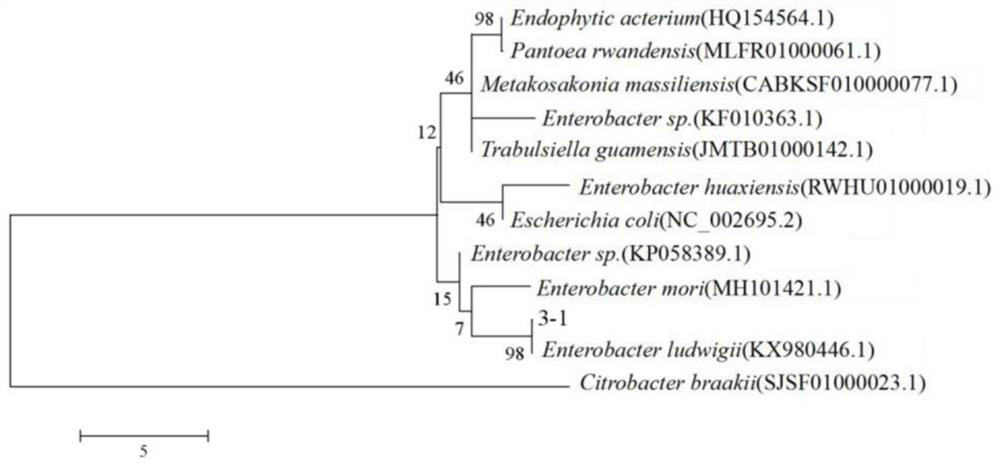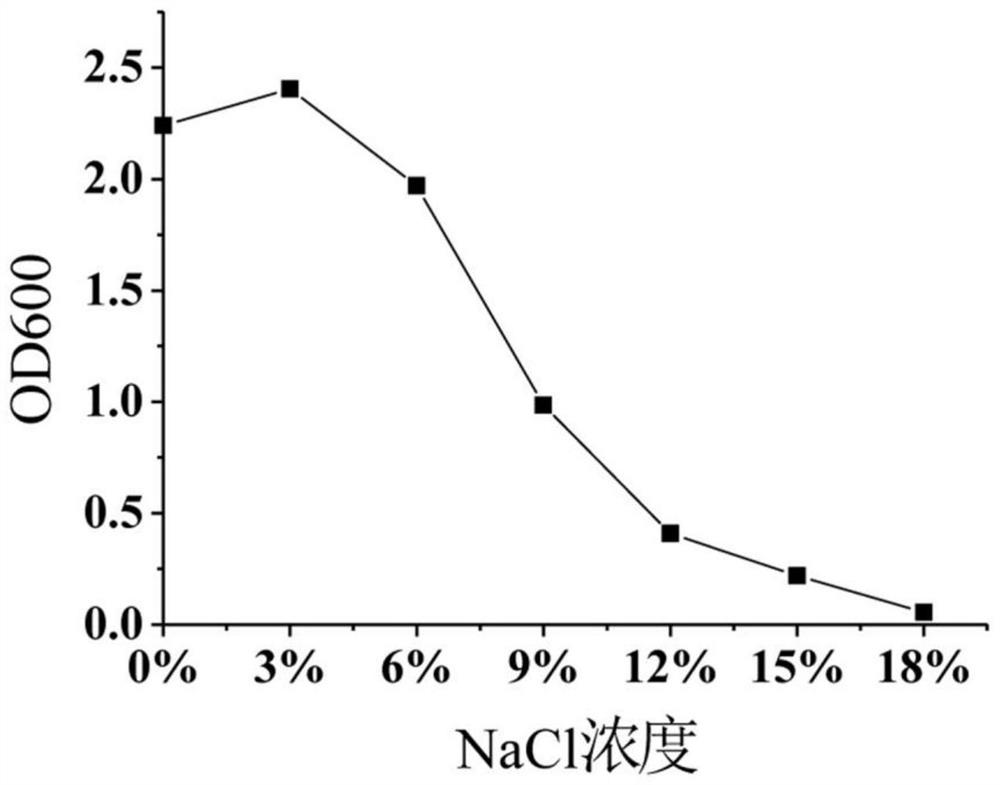Phosphate solubilizing bacterium 3-1 and application thereof in phosphate dissolving
A technology of insoluble phosphate and phosphate solubilizing bacteria, applied in the field of phosphate solubilizing bacteria, can solve the problems of acidification fertility, water pollution, soil compaction, etc., and achieve the effect of reducing the use of chemical fertilizers, increasing the content of available phosphorus, and alleviating soil compaction
- Summary
- Abstract
- Description
- Claims
- Application Information
AI Technical Summary
Problems solved by technology
Method used
Image
Examples
Embodiment 1
[0040] Example 1 Isolation and Screening of Phosphobacteria (Enterobacter ludwigii strain 3-1) 3-1
[0041] 1. Primary screening of strains
[0042] Soil samples were collected from the phosphate mine in Yichang City, Hubei Province (N: 31°13’55”N, E: 111°15’36”), put them into a sterile bag and brought them back to the laboratory, and stored them at 4°C. Weigh 10 g of fresh soil samples and add them to 90 mL of sterile saline, shake at 100 r / min for 15 min, and place them in an incubator at 28°C for 24 h. After enrichment, the supernatant was diluted to 10 -3 、10 -4 、10 -5 For three gradients, 350 μL of each dilution was applied to the inorganic phosphorus screening solid medium, and each group had 3 parallels. Place it upside down in a 28°C incubator for 4-5 days, and observe the transparent circle. Pick the colonies with transparent circles and repeatedly streak and purify them. After purification, pick a single colony and transfer it to the slant of beef extract pepto...
Embodiment 2
[0045] Determination of Phosphorus Solubilizing Inorganic Phosphorus Ability
[0046] Prepare 100mL solid inorganic phosphorus screening medium with deionized water, sterilize at 121°C for 30 minutes, pour it into a disposable plate, and cool it for later use. Inoculate the phosphobacteria 3-1 preserved in Example 1 into the beef extract peptone liquid medium, culture on a shaker at 28°C and 200 r / min for 24 hours, take 10 μL of the seed liquid of phosphobacteria 3-1 and inoculate it with the spot inoculation method to the solid inorganic phosphorus screening medium plate, and cultured statically in a 28°C incubator. After 7d, observe and measure the bacterial circle and the phosphorus-dissolving circle size of its bacterial colony, and calculate the phosphorus-dissolving index: (phosphate-dissolving circle-bacterial circle) / bacterial circle.
[0047] Tricalcium phosphate, iron phosphate, and aluminum phosphate were used as the only phosphorus source to prepare liquid inorgan...
Embodiment 3
[0057] Determination of ability to dissolve organic phosphorus (lecithin is organic phosphorus)
[0058] Inoculate the phosphate solubilizing bacteria 3-1 preserved in Example 1 into beef extract peptone liquid medium, culture on a shaker at 28°C and 200r / min for 24h, take 1mL seed solution and centrifuge at 8000r / min for 5min, remove the supernatant, and Add 1mL of sterile water to the tube and beat until uniform, add Montina medium, 28°C, 200r / min shaking table fermentation culture for 5 days. Take 2mL fermentation broth and centrifuge at 12000r / min for 10min, and measure the soluble phosphorus content in the supernatant by molybdenum-antimony anti-colorimetry.
[0059] Table 3 Decomposition ability of phosphate solubilizing bacteria to lecithin
[0060]
[0061] The results showed that the ability of Enterobacter ludwigii strain 3-1 to decompose lecithin was 2.16mg / L.
PUM
 Login to View More
Login to View More Abstract
Description
Claims
Application Information
 Login to View More
Login to View More - R&D
- Intellectual Property
- Life Sciences
- Materials
- Tech Scout
- Unparalleled Data Quality
- Higher Quality Content
- 60% Fewer Hallucinations
Browse by: Latest US Patents, China's latest patents, Technical Efficacy Thesaurus, Application Domain, Technology Topic, Popular Technical Reports.
© 2025 PatSnap. All rights reserved.Legal|Privacy policy|Modern Slavery Act Transparency Statement|Sitemap|About US| Contact US: help@patsnap.com



